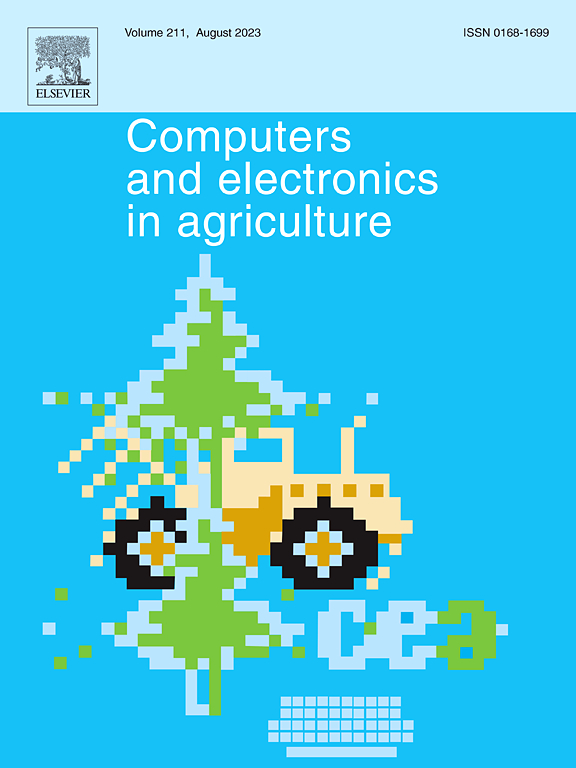基于纹理增强和多层关注融合的VGI农田图像作物自动检测超像素深度学习框架
IF 8.9
1区 农林科学
Q1 AGRICULTURE, MULTIDISCIPLINARY
引用次数: 0
摘要
志愿地理信息(VGI)图像作为农业大数据的重要来源,具有获取方便、数据量大、地理定位精确、分辨率高等关键优势。虽然作为基于遥感的作物制图的实地真值验证和卫星衍生监测的补充数据集具有双重作用,但其处理挑战包括空间异质性、巨大的数据规模、可变的图像质量和不一致的元数据。现有的方法难以同时解决不同作物类型的纹理歧义、上下文依赖和边缘保真度。为了解决这些问题,本研究提出了一个超像素精细的深度学习框架,该框架集成了纹理增强的DeepLabv3+架构和多层注意力融合。具体来说,我们引入了一个基于Gabor滤波器的纹理增强模块来捕获多尺度纹理细节,解决相似作物之间的颜色均匀性问题。分层注意机制融合了编码器层之间的位置依赖和通道依赖,增强了对分散作物分布的全局上下文感知。可分离卷积在保持精度的同时减少了计算开销。通过简单线性迭代聚类(SLIC)和基于投票的集成的超像素辅助细化进一步优化边缘描绘,特别是对于复杂的边界。实验结果表明,该方法的平均IoU为87.76%,精度为94.79%,Kappa系数为0.9133,优于经典网络。该框架的鲁棒性源于纹理先验、注意力驱动上下文建模和边缘保持优化的协同集成,为现实世界的精准农业应用奠定了基础。未来的工作将侧重于扩大数据集的多样性,以涵盖各种作物类型和环境条件,同时结合先进的计算技术来增强模型的鲁棒性和泛化能力,以用于现实世界的农业监测。本文章由计算机程序翻译,如有差异,请以英文原文为准。

Superpixel-refined deep learning framework with texture enhancement and multi-layer attention fusion for automatic crop detection in VGI cropland imagery
As a critical source of agricultural big data, images derived from volunteered geographic information (VGI) offer key advantages such as convenient acquisition, large data volume, precise geolocation, and high resolution. While serving dual roles as in-situ ground-truth validation for remote sensing-based crop mapping and supplementary datasets for satellite-derived monitoring, its processing challenges include spatial heterogeneity, enormous data scale, variable image quality, and inconsistent metadata. Existing methods struggle to simultaneously address texture ambiguity, contextual dependencies, and edge fidelity in diverse crop types. To tackle these issues, this study proposes a superpixel-refined deep learning framework integrating a texture-enhanced DeepLabv3+ architecture with multi-layer attention fusion. Specifically, we introduce a Gabor filter-based texture enhancement module to capture multi-scale textural details, addressing color homogeneity among similar crops. A hierarchical attention mechanism fuses positional and channel-wise dependencies across encoder layers, enhancing global context awareness for scattered crop distribution. Separable convolutions reduce computational overhead while maintaining accuracy. Superpixel-aided refinement via the simple linear iterative clustering (SLIC) and a voting-based ensemble further optimizes edge delineation, particularly for complex boundaries. Experimental results on the iCrop dataset demonstrate superior performance over classic networks, with a mean IoU of 87.76%, precision of 94.79%, and Kappa coefficient of 0.9133. The framework’s robustness stems from synergistic integration of texture priors, attention-driven context modeling, and edge-preserving optimization, establishing a foundation for real-world precision agriculture applications. Future work will focus on expanding dataset diversity to encompass various crop types and environmental conditions, while incorporating advanced computational techniques to enhance model robustness and generalization capabilities for real-world agricultural monitoring.
求助全文
通过发布文献求助,成功后即可免费获取论文全文。
去求助
来源期刊

Computers and Electronics in Agriculture
工程技术-计算机:跨学科应用
CiteScore
15.30
自引率
14.50%
发文量
800
审稿时长
62 days
期刊介绍:
Computers and Electronics in Agriculture provides international coverage of advancements in computer hardware, software, electronic instrumentation, and control systems applied to agricultural challenges. Encompassing agronomy, horticulture, forestry, aquaculture, and animal farming, the journal publishes original papers, reviews, and applications notes. It explores the use of computers and electronics in plant or animal agricultural production, covering topics like agricultural soils, water, pests, controlled environments, and waste. The scope extends to on-farm post-harvest operations and relevant technologies, including artificial intelligence, sensors, machine vision, robotics, networking, and simulation modeling. Its companion journal, Smart Agricultural Technology, continues the focus on smart applications in production agriculture.
 求助内容:
求助内容: 应助结果提醒方式:
应助结果提醒方式:


